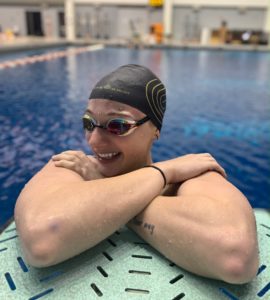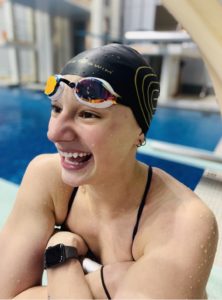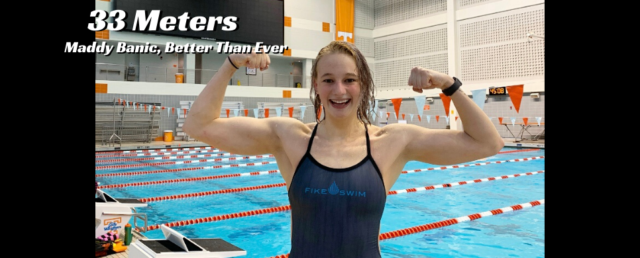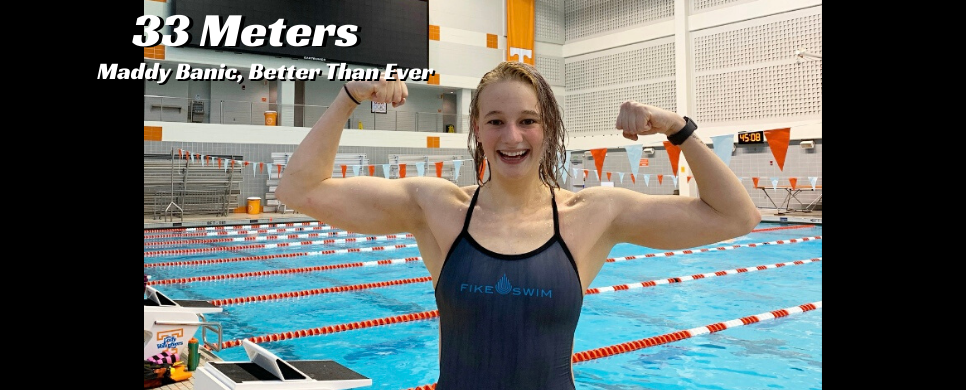“My swimming today isn’t where I want it to be, but I view myself now as an underdog who has to claw my way back.”
In 2017, Maddy Banic was on her way to becoming a household name as a top sprinter at The University of Tennessee. Her 21.54 in the 50 yard free at SECs ranked her 6th in the country and represented a 1.5 second drop from high school, but years of neglecting her mental health in favor of academic, athletic, and social performance became a weight she couldn’t hold anymore. Self-harm and alcohol abuse fueled by depression eventually led to an attempted suicide. After making the difficult, and admirable, decision to leave the school, the sport, and the team she loved so much to check in to rehab and get the professional help she needed, Maddy returned to the pool. But her journey back was only just beginning. This article looks at Maddy’s road to recovery and how she is better equipped now to compete for a spot on the U.S. Olympic Team than she was three years ago.
Kind of a Blur
Maddy’s depression started during her junior year of high school. She had just switched from YMCA to USA Swimming, school was getting harder as she moved into upper level classes and prepared to apply for college, and her commitment to band, her other passion, was strong. Always the perfectionist, Maddy couldn’t let anything slide or let anyone down, but “I was usually in a position of choosing whether to piss off my coach or my band director.” Balancing all three meant waking up at 3:30am to get to swim practice, then more swimming and/or band practice after school, followed by so much homework and college prep that a good night meant going to sleep at midnight. Sometimes her fatigue was so overwhelming she slept right through an alarm and missed swimming. “High school is kind of a blur.”
Not really equipped to understand depression at age 17 (thanks somewhat to the persistent stigma in our society against mental health problems and discussing them), Maddy figured many of the emotions she was feeling were simply stress from being over-worked. Unfortunately her method of dealing with the emotions was to self-harm. “Swimsuits don’t hide much, so I would cut my wrists because that was an easy place to cover up with bracelets. The cuts would heal in a couple days.” As hard as it was to tell her mom and to go see a therapist, the maintenance of therapy was even harder. “I didn’t like going, especially because my mom took me and I’m a very independent person.” Her pride prevented further treatment and one session was the end of it, for now.
A Kid in a Candy Shop
Maddy went off to the University of Tennessee in the fall of 2015, and actually started seeing a therapist regularly. She dropped the pride and tough girl persona. “College was fun in the beginning. I loved being away from home on my own and focusing on swimming with none of the extra requirements and commitments. I felt like a kid in a candy shop.” Her confidence was through the roof and it was reflected in her swimming, with one lifetime best after another. But in spite of regular therapy, Maddy wasn’t tackling her depression, just compartmentalizing it. Mental health issues like depression don’t just go away, and Maddy had buried hers for a while. Everything boiled up at the end of her sophomore year, which ironically was also her most successful in the pool.
Alcohol abuse took the place of self-harming in college. It was “a way to feel something. I had periods of time where I was totally numb to everything going on in my world, then periods of sadness that eventually turned into periods of numbness again.” Somehow through all of this she managed to swim the 6th best time in the country in the 50 free (21.54) at SECs her sophomore year. But like someone holding a weight over their head, it could only last so long. An attempted suicide, prevented by her roommate, scared Maddy into ending the downward spiral and getting serious help.
A Step Back
Maddy had been running on all cylinders for years, trying to perfect everything in her life. One week into her junior year at Tennessee, Maddy left the school, the team, and the sport she loved to check into a treatment center in Chicago called Timberline Knolls. She stayed for a month, in the in-patient wing for two weeks and then in an apartment on site for two weeks. “It was the most traumatizing but also most helpful period.”
 “Being gone for a month felt like years. I burned a lot of bridges and hurt a lot of people before I left. Teammates stayed up with me all night during the worst of my troubles. And worse, I was very selfish about it- I expected them to help me and showed no appreciation for it.” It was their job to fix her, as she saw it, and that was very taxing on her friendships. “I think it was a breath of fresh air for my teammates who no longer had to “tend to Maddy” in addition to their own lives.” The situation had gotten so bad that teammates were shocked she came back. She knew coming back would be difficult, but it was harder than expected.
“Being gone for a month felt like years. I burned a lot of bridges and hurt a lot of people before I left. Teammates stayed up with me all night during the worst of my troubles. And worse, I was very selfish about it- I expected them to help me and showed no appreciation for it.” It was their job to fix her, as she saw it, and that was very taxing on her friendships. “I think it was a breath of fresh air for my teammates who no longer had to “tend to Maddy” in addition to their own lives.” The situation had gotten so bad that teammates were shocked she came back. She knew coming back would be difficult, but it was harder than expected.
“I didn’t want to keep being the victim, I wanted to be a leader and help the team the way they helped me.”
Two Steps Forward
After one month, Maddy returned to a school, a team, and a sport that had to move on while she was away. She had a lot of work to do to catch up. She was a bit of an island unto herself when she returned to Tennessee, but she worked hard to rebuild friendships. She sat down with her teammates one or more at a time, sometimes several times over, and worked through tough, raw feelings. Her atonement and efforts to reintegrate were so good that her teammates voted her a captain her senior year. Her times never recovered, though.
She assumed that her junior year slump was due to everything that happened early in the season. But after the slump continued into her senior year, it was obvious- in her usual type A way, Maddy worked a bit too hard to prove herself and swam herself into a hole she couldn’t taper out of. “I didn’t want to keep being the victim, I wanted to be a leader and help the team the way they helped me.” Every practice, every set, everything that involved swimming was done at 100%. She ran herself into the ground trying to make up for the first two years. In hindsight, and rather ironically, Maddy’s success her freshman and sophomore years was probably because her health issues frequently pulled her out of practices, which made each season like a prolonged taper.
She finished NCAA Championships in March 2019 and retired from swimming, unsatisfied with her times but relieved to finally have control over her depression. “I wanted to move on and speak out for mental health, which is something I love doing. I ended as a national champion with the relay and that was a great way to go out.”
Maddy’s Comeback
After three months of retirement Maddy started missing swimming and couldn’t help but feel like she never reached her potential. And with her penchant for perfection, that was a nagging feeling that had to be addressed. “I figured Trials is one more year away and I might as well see what else I have in me. I had to know.” She started practicing again in July 2019 but she now recognized the pitfall of over-training, so she rethought her approach. Maybe less swimming and more strength was the answer. “I wanted to get bigger, a lot bigger. A lot of July and August were focused on weights. I did 4 weight sessions and about five swimming practices per week. My weight got to 155lbs from 145, but I felt heavy in the water. So now I’m at 150, still feeling a bit heavy, trying to get back to 145 while keeping the strength gains.” In the pool, she took a less-is-more approach. “I got great advice from Brett Hawke, who told me to swim slow when it’s time to swim slow and fast when it’s time to swim fast.” That may seem rather obvious, but swimmers have a tendency to train like sled dogs. What he meant was don’t do an ounce more than what was prescribed, except when it comes time to swimming fast, then pour everything you have into it like you’re racing. Not a little fast sometimes and really fast other times, but all out sprint when it’s time to go fast.
 A great example of her new approach is the way she handles the following set:
A great example of her new approach is the way she handles the following set:
3 Rounds:
- 4×25 @ :40 fast
- 2×25 @ :30 underwater dolphin kick, all out
- 2×75 @ 1:10 desc 1-6
In college she would have worked the whole set including the 75s, trying to win everything. These days, though, she focuses on winning the 25s and uses the 75s as recovery, maybe pushing the last one. The training at UT matches well with her philosophy. “We’re always doing something different. There’s no mindless swimming, no 300 just to swim a 300. There’s something prescribed for each 25 of that 300, whether it’s a drill or a stroke count or whatever. We emphasize quality over quantity.”
Her mental game has improved too. She has learned to recognize the triggers that cause her depression. “If something disappointing happens, the worst thing I can do is isolate myself in my room and dwell on the disappointment. But I have a lot of tools to help pull myself out of ruts, like talking to my therapist and friends, petting my dog who picks up on my anxiety, drawing, writing, and just getting out and going for a ride in the car.”
It has been a rollercoaster ride for Maddy, but no matter the destination, the journey has been invaluable. That’s important in a sport where experience and mental toughness are almost as important as physical ability. “My swimming today isn’t where I want it to be, but I view myself now as an underdog who has to claw my way back.”
You can support Fike Swim Ambassador Maddy on her journey to Tokyo by following her on social:
TWITTER.COM @madeline_banic
FACEBOOK Madeline Banic
INSTAGRAM @maddog3468
And get all the latest from Fike Swim:
FACEBOOK Fike Swim
YOUTUBE Fike Swim
INSTAGRAM @fikeswim
NEWSLETTER subscribe at www.FikeSwim.com for pro workouts, technique tips, promos, and more!
About 33 Meters
These articles are meant to shine a deserving spotlight on our ambassadors, who are usually living between two worlds: the swimming world and the “real” world. As any competitive swimmer knows, life outside the pool is a juggling act, one that gets even harder when you are no longer a student-athlete and have to pay your own bills.

About Fike Swim
“We design products exclusively for the toughest sport in the world. We unapologetically place swimmers on a pedestal. The rigors they embrace on a daily basis can only be understood by another swimmer and they deserve a company focused 100% on helping them succeed. Whether you’re just starting out or training for Tokyo, we stand behind you.”
– James Fike, Founder
Fike Swim Products was born when founder James Fike put a brick on top of a kickboard and transformed just another legs-only kick set into a total body workout felt into the next day. Since then it’s been our mission to create unique swim equipment with the single-minded goal of making you faster. We don’t sell toys. We create tools to help you reach your potential.
Swimming news is courtesy of Fike Swim, a SwimSwam Partner.


Thank you Maddy for being yourself and sharing your struggles. Stay strong!
All the best to Maddy! As a high school teacher for 34 years, I can tell society does not realize how much stress teenagers can go through. Advanced classes, outside activities, athletic teams, college prep, and – in some cases – a job. Too many kids are pressured, pushed, and pulled in several directions all in the pursuit of excellence…sometimes kids just got to be kids. Kids don’t have to excel at everything. I hope the extra year gives Maddy the chance to make an Olympic dream come true…and enjoy the road on the way.
It takes a lot of courage to share mental health issues. I will pray for Maddie and hope to see her swim fast at Trials in 2021!!!!